(h817 - block 1, activity 16)
Working in a organisation which is not primarily focused on education, none of the emerging techonologies mentioned in Johnson and Adams (2001) had yet had a significant impact on training. There is however a lot of potential in most of them for learning and teaching in the travel industry and I would like to highlight the follwoing three technologies.
1. Tablet computing
Many of our learners need to be on the road quite a lot to do their job:
- they are usually responsible for several geographically distributed destinations
- they often rotate destinations from holiday season to holiday season
- they need to be close to customers who are travelling themselves
Because tablets are highly mobile and combine most of the functionalities of laptops and smart phones and in addition can also be used to present products like for example excursions to customers using text, pictures, and videos, etc., many of our staff at the destinations are equipped with tablets. Therefore it is only logical that we are currently looking into improving our software courses for tablets.
With a colleague, I am currently looking into an interesting new feature - though not restricted to mobiles - which will be released with the next version of Adobe Captivate. It will enable learners and trainers to communicate via Twitter from within a Captivate eLearning module.
It works by registering a Twitter account when publishing the course. This then allows you to tweet questions about each slide. When students launch the course, they can review and reply to the questions you have tweeted. Likewise, they can tweet questions to you.
This really could add an exciting social context to programed elearning content.
For those who are interested, have a look at the short demos of the Twitter Widget via YouTube:
Part 1: http://www.youtube.com/watch?v=X6FeQ_g3RaE&feature=share&list=UULpsk3UF7lh5l9fVkLIqu6g
Part 2: http://www.youtube.com/watch?v=Z0Mf8BYFpSs
Part 3: http://www.youtube.com/watch?v=bBzPz9eKqAU&list=UULpsk3UF7lh5l9fVkLIqu6g
Part 4: http://www.youtube.com/watch?v=8WNwtuhKLBU
2. Learning analytics
Our organization has only recently introduced a new business analysis system. Its primary focus is analysis of financial data, but the critical business needs seem to be more or less covered by now and the team supporting the application has gained enough know how to plug in other systems and source their data. Once there is a sufficiently solid database it would be very interesting to combine it with data from our VLE and create reports to measure the effectiveness of learning initiatives.
3. Augmented reality
There are obvious opportunities for the tourism industry to use augmented reality, e.g. provide locations with additional information such as historical maps or interactive audio visual content. But of course I can also think of similar usage for educational purposes, e.g. to teach expert destination knowledge. In this highly competitive market, the ability to offer niche advice is a key factor for a tour operator and AR could be a way to contextualize such knowledge.
References
Johnson, L. and Adams, S. (2011) Technology Outlook: UK Tertiary Education 2011–2016, NMC Horizon Report Regional Analysis, Austin, TX, The New Media Consortium; also available online at http://www.nmc.org/ publications/ technology-outlook-uk-tertiary-education (accessed 3 March 2013).
